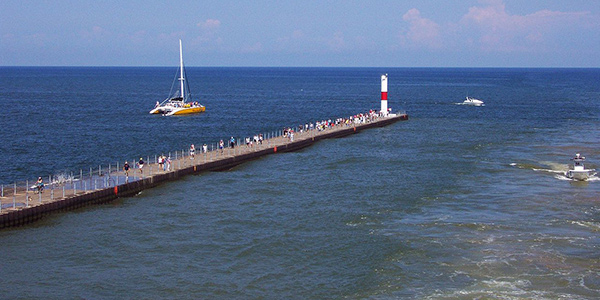New York has launched a study to identify how the state could tap wind resources on Lake Ontario and Lake Erie in meeting its climate goals.
The New York State Environmental and Research Development Authority assembled a team to complete a Great Lakes wind power feasibility study for release early next year, Gregory Lampman, environmental research program manager, said Friday.
A variety of factors concerning citing on the two lakes suggest the “study needs to be very dynamic,” Lampman said during a public outreach webinar.
“Certain site conditions will allow for fixed foundations, while other site conditions may require floating foundations, or they may be on different development timelines, and as a result the timing in which they would come into play will be different,” he said.
The New York State Public Service Commission directed NYSERDA in an October order to conduct the study with a $1 million budget.
NYSERDA retained the National Renewable Energy Laboratory to coordinate the report in conjunction with Pterra, Brattle Group and Advisian Worley Group.
Pterra and Brattle will study grid infrastructure components of the study, while Advisian will cover environmental concerns and regulatory processes, Lampman said.
Friday’s webinar was the first in a series of outreach events NYSERDA has planned for this year. Dates for two webinars will be announced for the second and third quarters to provide an update on the study’s progress. Another webinar will be held in the fourth quarter when a draft of the study is completed.
Study Scope
NREL’s experience with floating wind turbines will inform the study’s review of the technologies that could be deployed in the Great Lakes.
The NREL team will look at the infrastructure and physical constraints associated with technology deployment and assess the timeline for new product developments, Lampman said. In addition, NREL will identify what site conditions, such as icing and wave action, will affect project development.
Technology selections and location of deployments play into costs and generation opportunities, Lampman said, adding that NREL will define how costs fit into any potential project portfolio.
The study will also help the state understand what it can do to advance the development of offshore technologies and “capture the economic development opportunities,” he said.
Pterra and the Brattle Group will bring their regional grid and interconnection expertise to the study.
Their primary focus will be on the interconnection opportunities associated with existing infrastructure to ensure that projects can deliver energy cost-effectively, Lampman said.
Advisian will be addressing a diverse set of factors, such as permitting and interconnection applications.
While permitting processes exist for offshore wind, Lampman said Advisian would address, for example, interregional issues within those processes and concerns about how to gain site control in the lakes.
The group will also address avian risks and work to present pathways to development that consider the needs of other waterway constituents, such as the shipping, fishing and recreational communities.
Further analysis will be provided on historical and cultural areas and public health benefits of the projects themselves, as well as visual impacts from the wind turbines.
Lampman said the scope of the project does not cover collecting new site condition information.
The study, he said, will be based on existing data that will be analyzed “in new ways to inform thinking.”



